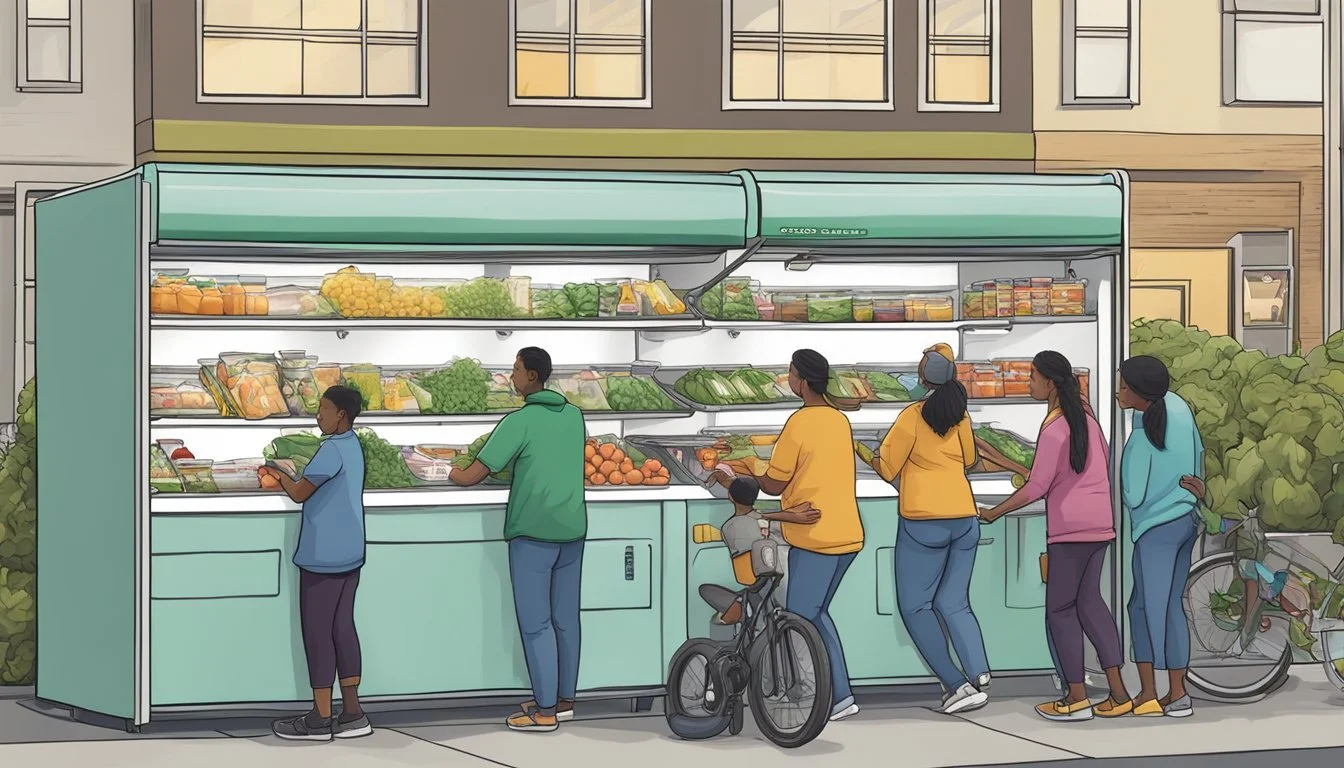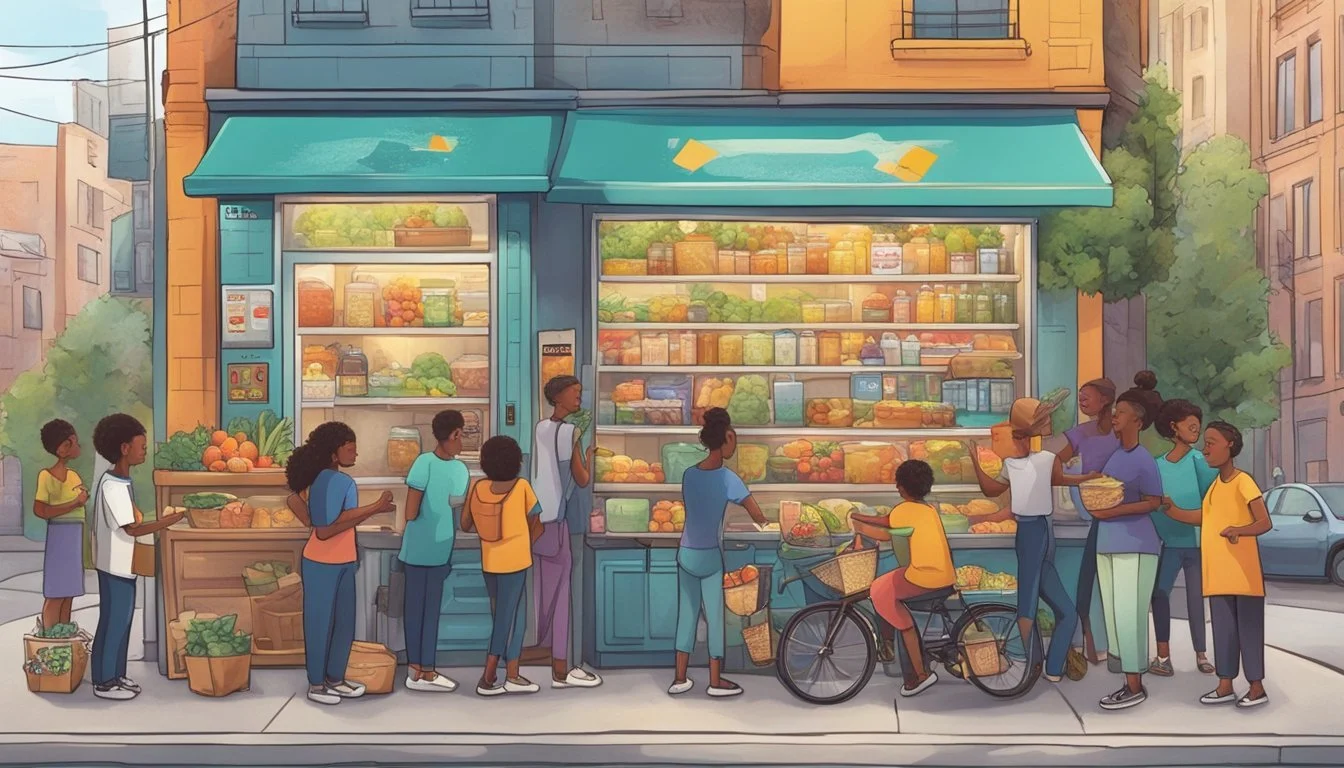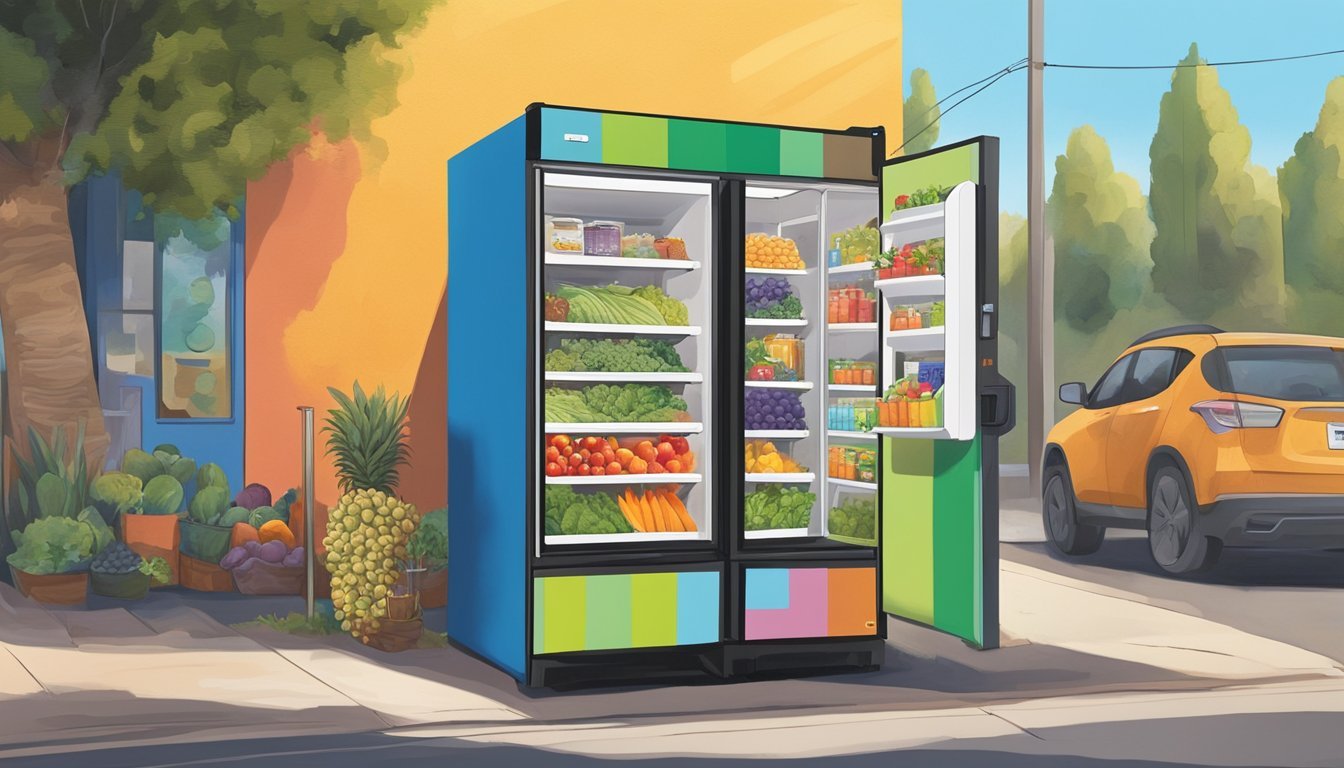Santa Clara, CA Community Fridge
Nourishing the Neighborhood
Community fridges in Santa Clara, California, are emerging as a vital resource in the fight against food insecurity and food waste. In accessible public spaces, these refrigerators offer surplus perishable food freely available for all community members, embodying the principle of sharing and mutual aid. The food is donated by local businesses, farms, and residents, and it operates on an honor system where individuals take what they need and contribute if they can.
The initiative not only supports residents in need but also provides an avenue for the community to tackle the broader issue of food waste. By redistributing edible food that would otherwise be discarded, Santa Clara’s community fridges help to save thousands of dollars worth of food that can go toward nourishing households and community groups. This effort is further complemented by the sense of community that grows around these hubs, as volunteer groups come together to organize, maintain, and stock these fridges regularly.
Santa Clara's embrace of community fridges reflects a commitment to sustainability and community resilience. These fridges serve as open resources for the community, while also fostering a spirit of sharing and caring. As a result, they provide not just a stopgap for immediate needs but also a symbol of the community's collaborative spirit and its dedication to ensuring no one goes hungry while perfectly good food remains available.
History and Purpose of Community Fridges in Santa Clara
Community fridges in Santa Clara serve as grassroots solutions to food insecurity, and their relevance surged during the COVID-19 pandemic. Not only do they provide free access to food for those in need, but they also contribute to reducing waste destined for landfills.
Origins of the Community Fridge Movement
The movement of community fridges, sometimes known as "freedges," began as a way to allow people to share surplus food with fellow community members. It is based on a simple yet powerful concept: anyone may take what they need and leave what they don't. These fridges offer a two-fold benefit: they address the issue of food scarcity among vulnerable populations and reduce food waste by redistributing excess food that might otherwise end up in landfills.
Impact of COVID-19 on Food Insecurity
With the onset of the COVID-19 pandemic, Santa Clara, like many places around the world, witnessed a sharp increase in food insecurity. Many individuals and families found themselves in difficult financial situations due to job losses and economic downturns. Food insecurity became a more visible challenge, affecting a wider segment of the community.
Community Fridges as a Response to the Pandemic
In response to the heightened need caused by the pandemic, community fridges became an essential resource in Santa Clara. They have been supported by a network of local volunteers and organizations who stock the fridges with nutritious food options. The idea is to sustain community support in a safe, hygienic, and accessible manner, ensuring that all individuals have reliable access to food at a time when conventional food supply chains were under strain.
Operating a Community Fridge
Starting a community fridge in Santa Clara, CA, involves careful consideration in terms of location, adherence to health and safety regulations, and partnership with local stakeholders. Effective management is essential for the successful operation of these fridges.
Finding a Location and Managing Space
The selection of a strategic location is critical for maximizing accessibility to the community fridge. It should be placed in an area that is visible, easily reachable, and frequented by a diverse cross-section of community members. After identifying a potential site, organizers must obtain permissions and coordinate with property owners or managers. Spacing considerations should accommodate not just the fridge itself but also allow for enough room for circulation and social distancing if needed.
Criteria for Location Selection:
High traffic area with easy community access
Safe and well-lit environment
Space Management:
Sufficient room for fridge, freezer (if available), and users
Proper sheltering to protect the fridge from weather elements
Health and Safety Regulations
Maintaining health and safety standards is paramount for any food distribution service. Community fridges in Santa Clara must comply with local health codes, which include regular cleaning schedules, proper food labeling, and ensuring that the temperatures are kept at safe levels to prevent food spoilage. It is advisable to have a set of guidelines clearly displayed near the fridge for all to see. The Community Fridge Network provides resources and support on best practices to maintain these standards.
Health and Safety Checklist:
Compliance with local food safety and handling standards
Regular cleaning and maintenance routines
Temperature Monitoring:
Fridge: Maintain at 40°F (4°C) or below
Freezer: Maintain at 0°F (-18°C) or below
Collaboration with Local Businesses and Organizations
Building relationships with local businesses, restaurants, and charity organizations can sustain and grow a community fridge project. Donations from these entities can help to stock the fridge with a steady supply of food. Engaging local businesses to contribute resources or services can raise the profile of the endeavor within the community. Coordinating with existing food rescue organizations can help streamline the redistribution of surplus food to the fridge, ensuring minimal waste and maximum community benefit.
Engagement Strategies:
Form partnerships for regular food donations
Collaborate with businesses for resources like refrigerators or funding
Community Involvement:
Encourage local volunteers for monitoring and maintaining the fridge
Educate the community on the purpose and use of the fridge
Benefits of Community Fridges
Community fridges in Santa Clara, CA, serve as a nexus where excess food can be shared and food insecurity addressed. These refrigerators offer practical solutions to prevalent issues by connecting those with surplus to those in need, and in the process, fostering a sense of unity within the community.
Reduction of Food Waste
In Santa Clara, community fridges help reduce food waste by redirecting surplus perishable items that would otherwise end up in landfills. This not only alleviates the environmental burden but also translates into substantial savings for the community. By ensuring that excess food is consumed rather than thrown away, community fridges play a vital role in a more sustainable food ecosystem.
Food redirected: from potentially wasted to consumed
Environmental impact: less waste contributing to landfills
Economic savings: community and individuals save on potential costs
Supporting Residents with Low Income
Community fridges inherently support residents with low income, making them a key resource in Santa Clara's battle against hunger. By providing free access to nutritious food, these solidarity fridges directly impact the lives of those who might struggle to afford essentials, thereby increasing their disposable income for other necessities.
Access to nutritious food: available to all, especially impacting those with low income
Increased disposable income: money saved on food can support other basic needs
Building Solidarity in Santa Clara County
The presence of solidarity fridges within Santa Clara creates a tangible expression of community support and cohesiveness. These community fridges exemplify how shared resources can cultivate an environment of mutual aid, often becoming local hubs where residents not only share food but also connect and strengthen neighborhood ties.
Mutual aid: a system where community members support each other
Neighborhood ties: strengthened through shared community resources
Challenges and Considerations
The success of the Santa Clara Community Fridge hinges on effectively addressing volunteer engagement, donation consistency, and ensuring both equipment functionality and safety.
Sustaining Volunteer Engagement
Volunteers are vital to the productivity and upkeep of community fridges. Santa Clara must create a reliable volunteer base that is regularly trained and well-coordinated. The frequency of their engagement demands a flexible yet structured schedule to prevent burnout and ensure the initiative's longevity.
Recruitment: Constant effort to attract new volunteers.
Training: Providing comprehensive guidance on safety and operations.
Scheduling: Implementing a rotational system to share the workload.
Ensuring Continuous Food Donations
The community fridge relies on a steady stream of food donations to serve those in need. Securing partnerships with local businesses and farms could augment regular contributions from residents. It's crucial to balance the variety and quantity of donations, emphasizing nutritious options.
Food Sources:
Local supermarkets
Restaurants
Farms
Resident donations
Donation Types:
Fresh produce
Non-perishable items
Bold emphasis on nutritional value
Maintaining Equipment and Safety
Operational fridges require consistent maintenance and checks to avoid food spoiling. This includes ensuring proper heating regulation and combating any iron-related deterioration. Regular cleaning and safety inspections are crucial to prevent the spread of foodborne illnesses.
Maintenance Tasks:
Temperature monitoring for safe food storage
Rust inspection to avoid contamination
Safety Protocols:
Regular cleaning schedules
Routine health and safety audits
Community Involvement and Support
Community fridges in Santa Clara, CA depend heavily on the active participation of local residents and organizations to function effectively. Volunteers are the backbone of these initiatives, while donations maintain the supply of food, and social media is an indispensable tool to increase awareness and support.
How to Volunteer
Individuals interested in volunteering can contact local organizations managing community fridges to find out about available opportunities. Tasks for volunteers typically include:
Stocking and organizing the fridge with donated items.
Ensuring cleanliness and safety measures are upheld.
Managing logistics such as picking up food donations from partners.
Volunteers usually coordinate their efforts through online platforms or direct contact with fridge organizers.
Donation Guidelines
Donations are critical for community fridges to serve Santa Clara residents in need. Prospective donors should adhere to the following guidelines:
Food items should be unexpired and unopened.
Preferable donations include fresh fruits, vegetables, and non-perishable goods.
Consider avoiding items that have specific storage requirements, such as raw meat, due to food safety concerns.
Most community fridges will have clear signage or information online detailing acceptable and unacceptable items.
Raising Awareness through Social Media
Social media platforms like Facebook and Twitter serve as essential channels for raising awareness about community fridge locations, needs, and impact. Effective strategies include:
Using hashtags to increase visibility of posts.
Sharing pictures and stories of volunteers and beneficiaries to create a personal connection.
Posting regular updates about the fridge's inventory and specific donation needs.
Engagement on social media encourages community solidarity and broadens the reach for support and donations.
Conclusion
Community fridges have emerged as a significant contributor to addressing food insecurity in Santa Clara and the surrounding Bay Area. These resources, powered by community support and volunteerism, represent an evolving solution in the fight against hunger.
The Role of Community Fridges in Santa Clara's Future
In the landscape of Santa Clara, community fridges are more than just food storage units; they are beacons of collective action. Positioned in accessible public spaces, they serve as points where excess food can meet necessity, minimizing waste and providing immediate aid. Santa Clara's commitment to sustaining these fridges mirrors its dedication to fostering a supportive environment for all its residents.
Key Outcomes:
Reduction in Food Waste: Thousands of pounds of food rescued from spoilage.
Community Support: Increased awareness and participation in communal welfare initiatives.
Further Resources and Information
Residents and interested parties seeking more information on Santa Clara's community fridges can explore a variety of resources:
Local Volunteering Organizations: These groups offer updates on how to contribute to stocking and maintaining fridges.
Online Platforms: Websites and social media channels provide real-time locations and status of community fridges in the Bay Area.
San Jose Community Fridge Initiatives: Specific initiatives in the San Jose area can offer insights into the operational models and success stories.
For further enquiries or involvement:
Contact Local NGOs: Expertise and guidance on effective participation within the network.
Municipal Resources: City planning departments may furnish info about regulations, safety, and future plans concerning community fridges.
The effectiveness of community fridges in Santa Clara reflects an integral step towards a future where no resident faces food scarcity without recourse. They are not just standalone solutions but part of a synergistic approach to elevating the quality of life for everyone in the community.
Appendix
The Appendix section provides a resourceful guide to local community fridges in Santa Clara, CA, along with references to external community fridge networks. These community-driven initiatives aim to reduce food waste and improve food accessibility.
List of Local Community Fridges
Santa Clara, CA Community Fridges:
Honor Fridge One: Located at Central Park, offers perishable food items.
Honesty Fridge Two: Situated at the downtown transit center, provides non-perishable food and fresh produce.
Community fridges operate under the honesty policy, where community members are encouraged to take what they need and give what they can.
External Links to Community Fridge Networks
Hubbub's Community Fridge Network:
Official website: Hubbub's Community Fridge Network
A prominent organization supporting the community fridge movement with links to resources and guides on starting a community fridge.
Additional Networks:
Global Fridge Network Directory: Worldwide Community Fridge Locations
A comprehensive list of community fridges across the globe, including those in Santa Clara.








